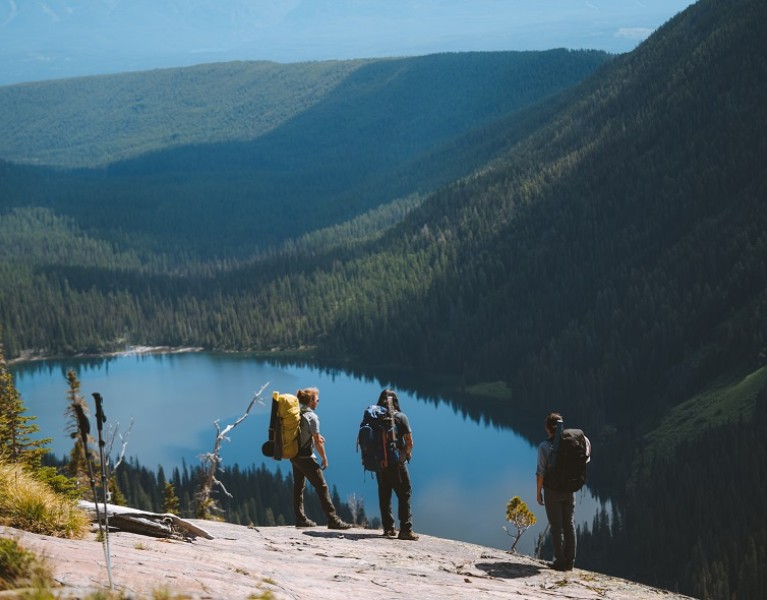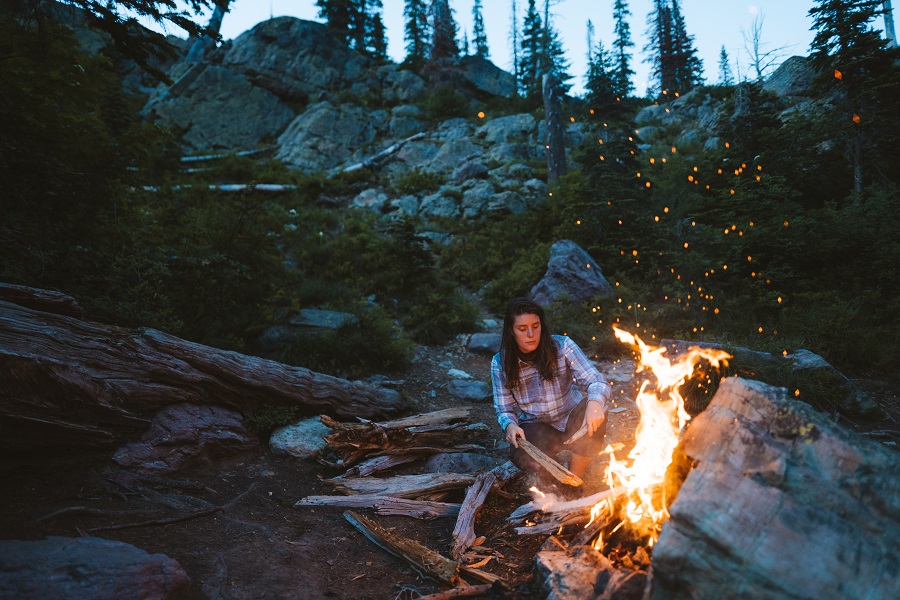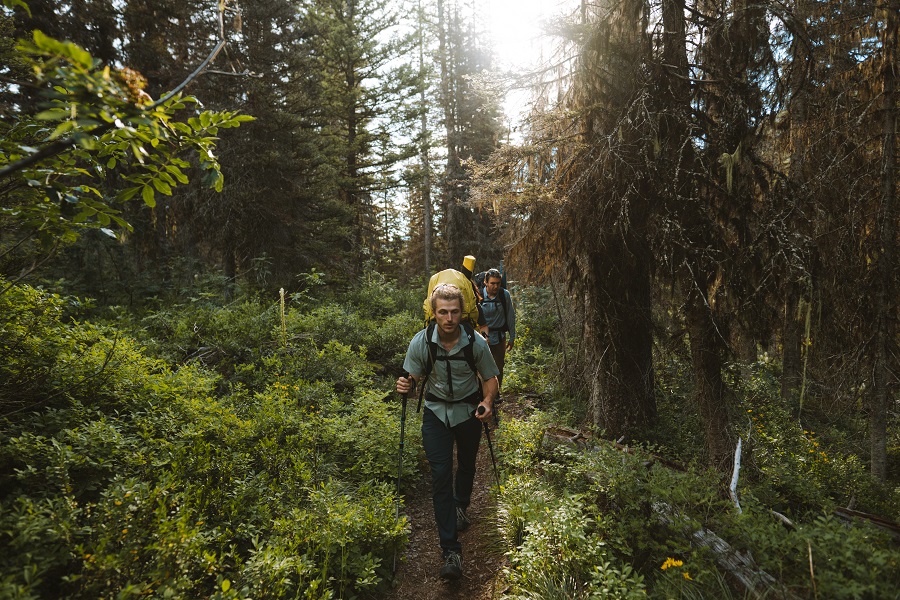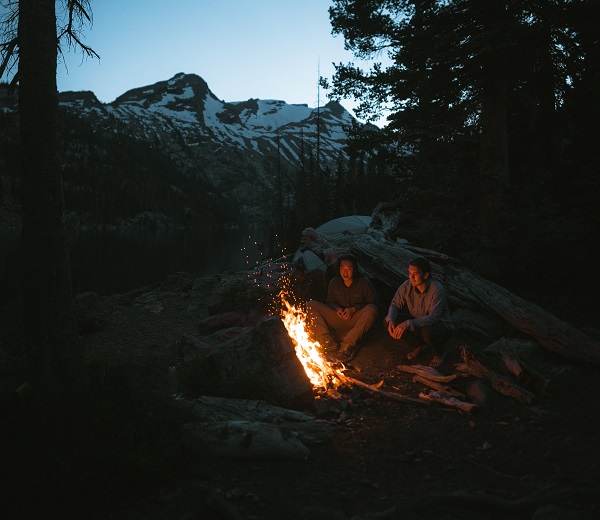- 1. Check yourself before you wreck yourself
- 1.1. How do I stop myself from freaking out?
- 1.2. Should I stay where I am or keep moving?
- 1.3. How can I attract the attention of rescuers?
- 1.4. Am I at risk of hypothermia or heat stroke?
- 1.5. Do I have enough water?
- 1.6. Am I gonna starve?
- 1.7. Psychological preservation
- 2. Be ready for an unexpected camp out
- 3. There's no shame in being prepared

Lose the Trail? How to Survive Until Help Arrives
Table of Contents [Show]
This past spring, I joined some friends to hike on California's Mount Tamalpais. At the trailhead, I caught some grief when I shouldered my daypack. "Are you serious? It's less than four miles," said my former roommate.
"Hopefully there's box wine in there," said his wife (I think she meant it).
It wasn't box wine. I'd packed everything I needed need for an unexpected overnight trip. I've heard too many stories of experienced hikers accidentally wandering off the trail and getting lost for days on end, and I don't want to take any chances. The folks at SmokyMountains.com, a tourism-oriented site, put together a fantastic study of hikers who lost their way, and reading it was both an enlightening and gratifying experience. Their data backs up my healthy paranoia.
If you do get lost, and you're not prepared with the right equipment, at least have the right mindset to get you through.
Check yourself before you wreck yourself
This is a fantastic time to be less-than-dramatic. The second you even suspect that you're lost, stop in your tracks. Look around you for familiar landmarks that might help you determine where you came from, and where you were headed. Consider angles-of-view; geographic features and funky trees can look very different when viewed from a slightly different perspective.
Whether or not you think you've figured out your bearings, sit down and rest a few minutes. If you aren't certain how to find your way back to the trail, stay put and assess your situation:
How do I stop myself from freaking out?
Deep breathing—the kind that forces your tummy outward—does more than help you focus. It stimulates the vagus nerve, which in a nutshell signals your brain to chill out. Panic triggers the flight response, and the last thing you want to do is move blindly toward where you think you need to go. Find the nearest shade, sit down, drink some water, have a snack, recharge, and clear your mind.

Should I stay where I am or keep moving?
The answer to this question is entirely dependent on the situation. In other words, "stay where you are until someone finds you" isn't always good advice. Nor is "follow a stream downhill" if it sends you through dangerous terrain or into heavy cover where you won't be seen from above. These are variables that may affect your game plan:
- You want to be visible, but close to shelter
- The visibility is poor
- You have to travel some distance to locate water, shelter, or shelter-making materials
- You have no orienteering skills or tools
- You're pretty certain your phone will get a few bars if you head to high ground
- You're injured and can't go anywhere
- You've brought everything you need to stay safe in an emergency, including a personal location beacon
- You dressed as if you were headed to your mailbox
- Your hiking buddies can make an educated guess as to where and when you left the trail
- You told nobody where you were going, and when you'd check in upon your return
- It's a well-traveled area covered with a network of established trails
- You're in the middle of freaking nowhere
When you're lost, don't do anything unless you have a good reason to do so, and don't take unnecessary risks that could cause injury. Think about every move—preferably at least three steps in advance—and always take into consideration your physical condition. If you're tired, thirsty, and stressed, you're more likely to make bad judgment calls and have crappy coordination.
When you're lost, "Leave No Trace" goes out the window. If you decide to keep moving, mark your trail. Break branches at shoulder-height, or use your knife to make marks in tree bark. Make directional arrows with stones, or hang bits of reflective paracord here and there as breadcrumbs.
How can I attract the attention of rescuers?
If you were hiking with buddies, first try calling out. If you don't get a response, use your whistle: Three three-second blasts, with the pattern repeated every ten seconds or so, is the standard whistle distress signal. During those ten "in-between" seconds, take deep, centering breaths, and listen for replies. Direct audio signals upwards if you're in a canyon, and in combination with flashing signals in every direction to help them locate the source of the sound.
Only build a signal fire if there is no chance of setting off a wildfire and making your day even worse than it already is. Use wet wood, green leaves, or moss to produce smoke. Rubber or plastic will cause darker smoke; just don't inhale it—in fact, don't breath in any smoke from plant material that could irritate your eyes, skin, or lungs.
I'm a huge fan of satellite beacons, but no single signaling device is bombproof. As they say in the Special Forces, "two is one and one is none." The takeaway? Always bring multiple options for letting people know where you are, in any terrain, including those that will help rescuers locate you if you're immobile.
Most outdoor clothing and equipment manufacturers incorporate reflective trim in their products, but what if that reflective material was detectable through 65 feet of snow? Pretty crazy concept, right? But it's here. Swedish rescue technology company RECCO® developed radar-reflective material that responds to handheld or helicopter-mounted detection units. There's no need for the wearer to charge or activate anything; just like traditional reflective tape, it's reactive. In August 2019, KÜHL announced that it's the first and only outdoor clothing company offering RECCO® rescue reflectors in summer-season outdoor adventure wear.

Am I at risk of hypothermia or heat stroke?
If you've decided you're on your own for a while, make thermoregulation your highest priority. Hold your palm sideways between the horizon and the sun to figure out how much time you have before temperatures drop and you lose visibility. Each finger width is approximately 15 minutes. Are you prepared for cold temperatures when the sun goes down? How long will you have to deal with brutal heat? Can you get a shelter together before dark so you don't go skipping off a cliff?
Your clothes are your best source of warmth—above camping equipment and fires. If your hiking clothes or boots are damp, wet, or sweaty, remove them and put them where they'll dry. If you're dirty, shake out the clothes closest to your skin, and put them where they'll get direct sunlight. This helps keep them clean, reducing irritation and improving the fabric's insulating properties.
Gather up dry leaves, moss, and grass in case you need to stuff your clothes for extra insulation. Sleeping on a bed of dry, fluffy material will reduce heat transfer from your body to the ground, and snuggling under a layer will insulate you from cold air. If there's no danger of rockfall, set up camp near something solid; its thermal mass will release heat during the night. Protect yourself from precipitation by building a simple lean-to, and if there's significant snow on the ground, build a snow cave with adequate ventilation.
Do I have enough water?
Drink the water you have with you when you're thirsty. Don't ration it. Dehydration increases your risk of hypothermia and heat sickness and contributes to poor decision making. As I already mentioned, the choices you make early in your misadventure are the most important.
If you didn't pack some form of mechanical or chemical water purification, filter dirty water through a bandana or clothing, or just go for it and drink from running water. Giardia doesn't kick in until one to three weeks after you've been infected, but you won't last more than three days without water.
Other options for scrounging water include:
- Squeezing moisture from moss, or licking it from plants
- Collecting water in an improvised solar still (and using sunlight to sanitize found water)
- Catching condensation or rainfall on a plastic sheet, e.g. a ground cloth, Mylar survival blanket, or garbage bag
If you're in the desert, don't go cutting into cacti for water. It will quickly make you sick. Which brings me to this: Avoid moisture loss at all costs. Stay in the shade during the hottest part of the day, breathe through your nose, and wear loose, cool, UV-resistant clothing. Don't exert yourself unless you absolutely have to.
Am I gonna starve?
Adult humans can go 30 days without food, but stress, cold temperatures, and activity can move the timeline up a bit. If you didn't pack some hearty snacks for your day trip, or you're out of your standard backcountry fare, you'll have to balance the need for food against the energy you'll expend finding it.
If you're dehydrated, your digestive system won't operate as efficiently as it should. After eating and drinking, rest for about 30 minutes to help your body do its job. If you've been without sufficient water, be wary of eating dry, tough, and high-fiber foods.
Learn to identify the edible and poisonous plants (and insects!) in your area, and brush up on making simple snares for small mammals. If you packed more food than you think you'll need for your trip, eating grasshoppers and voles will be the last resort, though I'm always up for trapping crawdads regardless of my situation.
Psychological preservation
Once again, it's extremely important to stay calm, and do whatever you need to do to stay positive. If you're religious, pray. Meditation will relax you and also help your body relax. Talk out loud to the critters you see or make up horribly inappropriate lyrics to your favorite songs. Think whatever thoughts keep you motivated.

Be ready for an unexpected camp out
My standard out-for-the-afternoon pack really doesn't weigh much at all. Most of the bulk comes from a down jacket and water bladder system. Here's what else I carry:
- Sharp, high-quality multitool
- Extra merino wool socks
- Knit wool cap
- Wool fingerless gloves
- LifeStraw portable water filter
- Waterproof matches AND Bic lighter
- Prescription pill bottle filled with Vaseline-soaked cotton balls
- First aid kit with 5 days of prescription meds (rotated out of my kit monthly)
- 2 Mylar space blankets
- SOL emergency bivvy
- Whistle
- Signal mirror
- Compass and topo maps
- Phone with OnX map app
- SPOT Gen3 Satellite GPS Messenger
- Bandana
- Blaze-orange reflective paracord
- LED headlamp
- Individual packets of fruit-flavored Pedialyte powder (more to improve the taste of icky water than to replace electrolytes)
- Mainstay emergency ration bars (they're good, but I'm pretty good about not looting them on a non-emergency basis)
I keep everything but my phone, outerwear, and SPOT smooshed up in a waterproof compression sack. I attach the GPS messenger to the outside of my pack so it's always ready to go. I've found that keeping my core emergency gear separate from the rest of the stuff in my pack reduces the likelihood that it will get "borrowed" for other purposes. I'll throw in an extra fleece as well as my favorite trail snacks, sunscreen, bug spray, and the usual Leave No Trace personal care items and accessories.
Drink plenty of water the day before and the morning of your hike; "feed up" on a hearty breakfast a half hour or so before you head out; and be rested. Be sure to tell a trusted friend where you plan to go and when you expect to return. Tell them you'll contact them at a certain time, and be clear that you want them to call for help if you fail to do so.
Finally, don't hike alone, and don't tackle hikes that are well above your skill and fitness level.
There's no shame in being prepared
"You're not paranoid if they really are out to get you." Have you heard that one? Well, nature is out to get you, and a bit of precaution will make the difference between tragedy and a moderately sucky night huddled under a space blanket.
If you're not convinced, check out SmokyMountains.com's "Safe & Found" site, especially the breakdown of rescued hikers' experiences: How long they were out, where they got lost, what they did to survive. You'll be putting together your pack in a heartbeat. If you do it right, you'll have plenty of room for that wine.


